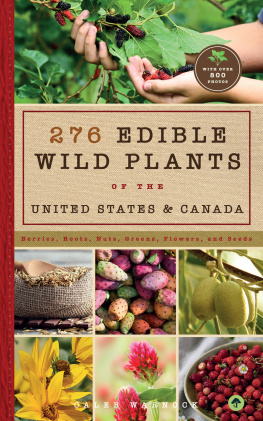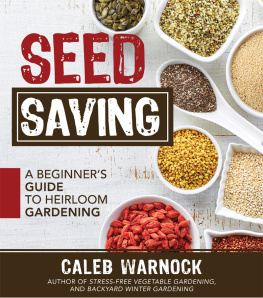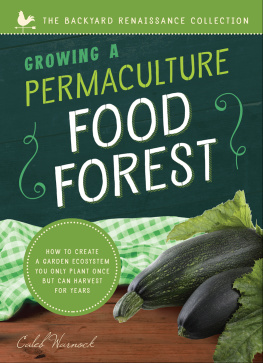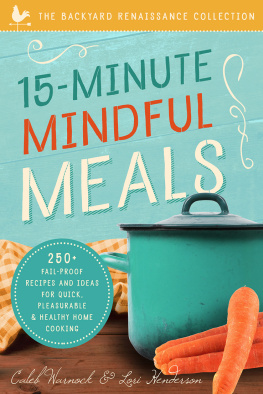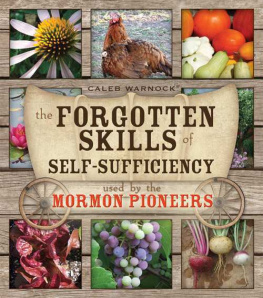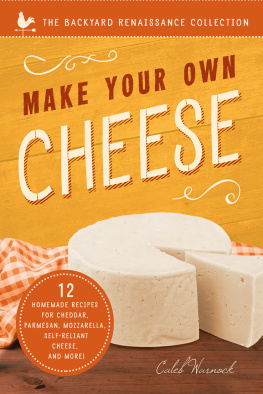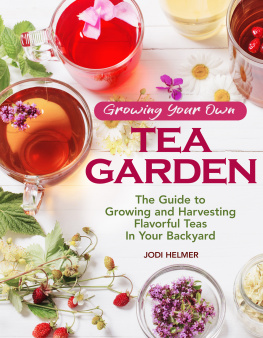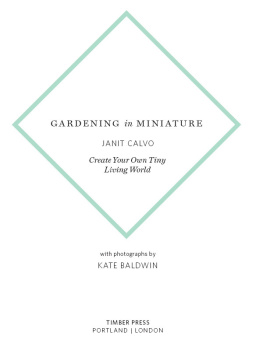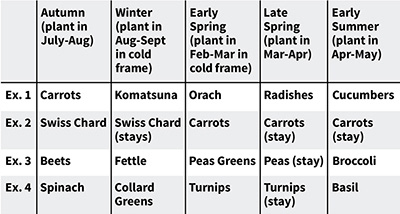
Discover the
Long-Lost Skills of
Self-Reliance
M y name is Caleb Warnock, and Ive been working for years to learn how to return to forgotten skills, the skills of our ancestors. As our world becomes increasingly unstable, self-reliance becomes invaluable. Throughout this series, Backyard Renaissance , I will share with you the lost skills of self-sufficiency and healthy living. Come with me and other do-it-yourself experimenters, and rediscover the joys and success of simple self-reliance.

Copyright 2017 by Caleb Warnock
All rights reserved.
Published by Familius LLC, www.familius.com
Familius books are available at special discounts for bulk purchases, whether for sales promotions or for family or corporate use. For more information, contact
Familius Sales at 559-876-2170 or email .
Reproduction of this book in any manner, in whole or in part, without
written permission of the publisher is prohibited.
Library of Congress Cataloging-in-Publication Data
2016961876
Print ISBN 9781942934844
Ebook ISBN 9781944822415
Printed in the United States of America
Edited by Julie Levitan
Cover design by David Miles
Book design by David Miles and Kurt Wahlner
10 9 8 7 6 5 4 3 2 1
First Edition
Dedicated in memoriam to my grandparents, Robert and Phyllis Warnock, who had the largest vegetable garden I ever saw and gave me strawberry plants and a pamphlet on how to grow them when I was in elementary school. My lifelong gardening obsession may be entirely your fault!
I miss you.
Welcome to Tiny Garden, Huge Harvest
In this book, you will find:
- Simple, effective techniques to maximize your harvest
- Information to help choose the right crops for your gardenand you
- Tips and tricks to better manage your garden
- Design advice and examples for even the tiniest garden
- A design worksheet and crop index to help create your own tiny garden (and a huge harvest)
The Benefits of a Tiny Garden
A garden, small or large, allows us to reap the benefits of self-reliance and also gives us an opportunity to pass those lessons onto our children and grandchildren. Establishing a garden at home allows any family access to delicious, organic food without having to worry about the cost at the grocery store. Unfortunately, many families assume that because they dont have the time and space to maintain a larger garden, they cant have any garden at all.
But thats not true! For busy families, a tiny garden creates a manageable and sustainable workload. And for some people, a tiny garden means they can downsize when an existing large garden becomes impossible for health or time reasons.
I have had gardens of every size. My freshman year at college, my entire garden was in pots in the window. I even grew squash. I was crazy. I wasnt homesick, but I was super-sick of living in a rabbit hutch, crammed in with five roommates (even though they were the best roommates ever). Today, my garden may be the largest in my state. So I feel I can speak with authority on the benefits of both. The benefits of a tiny garden are the same benefits of living in a tiny houseyou spend much less time maintaining and cleaning. I have seen so many people become overwhelmed with their large gardens because they are designed wrong (big gardens are only possible when designed very carefully). People with tiny gardens are much less likely to give up on gardening, even when their garden is designed wrong. (For information on how to correctly design a garden, see my Successful Gardening class at SeedRenaissance.com .)
In November 2015, I harvested:
- 105 pounds of carrots from a 10-foot-by-2-foot bed
- 40 pounds of beets from a 6-foot-by-2-foot bed
- 34 pounds of parsnips from a 10-foot-by-2-foot bed
- 28 pounds of turnips from a 6-foot-by-2-foot bed
This is a total of 207 pounds of produce. Based on the prices at a local store, these organic vegetables would have cost me $847. Instead, I got all this from 64 square feet of gardenthats just 8 by 8 feet!
Harvesting these huge amounts from such a small space was only possible because of the strategies that Ive developed over the years. In the next section, you will find tips and tricks to help you get a huge harvest no matter how tiny your garden space iswhether it is a balcony or a bantam backyard.
Huge Harvest Tips and Techniques
Succession Cropping
This strategy involves planting and harvesting a series of different vegetables, one after the other. For example, in autumn, you might plant oracha cousin of spinachand harvest it throughout the autumn and winter under a cloche or cold frame. Then, in early spring, you would pull out the orach and plant radishes in the same spot. After harvesting the radishes in early summer, you could replace those again with lettuce. Then, in late May, you would pull out the lettuce and replace it with squash. Finally, when the squash is finished in autumn, you could replace it with orach and start the cycle again.
If you are new to gardening, you may think it strange to plan your garden cycle beginning in autumn, when most people are finished gardening. But for gardeners who practice self-reliance, the true garden cycle begins, not ends, in autumn.
You can read more about year-round gardening in my book Backyard Winter Gardening .
The chart offers some other succession crop options. Example 1 demonstrates a true succession rotation, in which different vegetables are planted each harvest. Example 2 offers a simpler rotation involving just two vegetables.
In Example 3, you will notice that I suggest you plant peas to harvest for pea greens in early spring and that those same pea plants remain in the garden so that you can harvest the actual pea pods in late spring. This is an example of getting two harvests from a single vegetable. You can see a different example of this concept in Example 4, where I suggest you plant turnips in early spring for harvesting the turnip greens; those same turnips are left in the garden so you can harvest the root bulbs in late spring. The next section offers more details on this method.
Succession Cropping
Greens-to-Roots Harvesting
Unlike true succession cropping, with this method you start by harvesting greens over a long time and end by harvesting the root vegetable. For example, you can plant a Chioggia beet in late spring or early autumn. It grows quickly, and within three weeks, you can harvest the outer leaves, which are wonderful raw in salads or cooked on their own. You do not take the center leaves, which will always be baby leaves because beets produce leaves from the center outward. Since beets produce leaves from the center outwards, you should only harvest the outermost leaves. Cutting down the inner leaves too much may prevent the beetroot from growing properly. You can harvest the outer leaves of each plant about every ten days through autumn, winter, spring, and early summer. Thats a huge harvest from one tiny plant. Then, just when the weather begins to warm, you harvest the bulb for eating.


